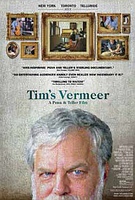Little Known Films: Tim’s Vermeer (2013) Documentary 80 Mins.
Everyone at one time has stood before a painting in an art museum and thought, I wish I could have done that. Frequently the work prompting the awe is by an Old Master, maybe a Rembrandt selfportrait, a winter scene by Pieter Bruegel the Elder, a Rubens nude. Most of us, of course, never act on the wish, claiming either various lacks (of talent, time, ambition) or simple humility in the presence of unattainable genius.
Tim's Vermeer, a highly entertaining lab experiment in art history presented with Las Vegas-style showmanship, focuses on two people: the seventeenth-century Dutch painter Johannes Vermeer, whose paintings possess such uncanny detail that they might be mistaken for perfectly-composed photographs, and Tim Jenison, a wealthy American who set himself the task of not only figuring out how the artist accomplished what he did but reproducing the technique himself. What seemed to make this the height of folly was that Jenison, born in 1955, had no training or experience as a painter. He made his fortune in helping Hollywood create fake scenes with his special effects software and hardware.The entire effort undertaken by Jenison which spans almost 2,000 days would have remained a largely unknown curiosity were it not for the decision of magician Penn.
Here’s how it all happened. Jenison was given a copy of the book Secret Knowledge by artist David Hockney, which caused a sensation and some art-historical upheaval about a dozen years ago by suggesting that some of the more revered artists of the Western canon used optical devices to create a realistic sense of perspective. Vermeer, known for his masterful depictions of light, has remained more of a mystery. Jenison begins to obsess over Vermeer’s techniques, culminating in re-creating one of the most beautiful and complex artworks ever made: Vermeer’s The Music Lesson.
Jenison walks Vermeer’s stomping grounds in Delft, learns Dutch, mixes his own paint, makes a giant lens from scratch, and builds a perfect replica of Vermeer’s studio in a San Antonio warehouse, right down to the 17th century furniture. He also gets a rare audience with the work itself at Buckingham Palace where no cameras were allowed in.
In the end, *Tim’s Vermeer* doesn’t answer the essential question that it raises. It proves that Johannes Vermeer could have used the sort of optical device that Jenison constructed. It doesn’t prove that he actually did but it makes the question all the more tantalizing by presenting it in concrete rather than merely theoretical terms.
If anything, *Tim’s Vermeer* refreshes our view of Vermeer, making him more of a modern artist and less a distant mirror. The film is currently on exhibition at the Palisades library


